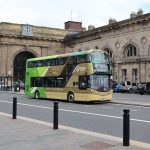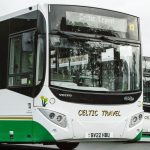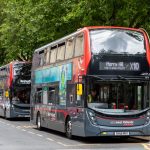The three new park-and-ride Salisbury Reds electric buses are a statement on the pressing need for improved air quality. It is also the perfect opportunity to talk modal shift
The frequency with which battery-electric buses are being unveiled is gaining pace. The new Salisbury Reds electric buses are the latest venture into zero-emission capability. They are a trio of BYD ADL Enviro200EV models in the distinctive red-and-black Salisbury Reds livery.

Salisbury Reds specification
The new electric vehicles (EVs) replace three diesel buses. The chassis and body follow standard BYD ADL layout, while the interiors have been customised to Go South Coast’s specification. Each EV offers 324kW/h battery capacity and a range of around 150-160 miles, according to the company. An arrangement sees the electricity for the vehicles come from renewable sources.
“One of the important things we specified is mirrorless buses,” explains Go South Coast Engineering Director Steve Hamilton. 21st Century has supplied its SmartVision camera monitoring system, which replaces the traditional wing mirrors with cameras. In addition to reducing the risk of collision with objects and pedestrians, the company claims a modest fuel saving from reduced drag, and improved blind spot monitoring.
“The vehicles also come equipped with USB charging ports, next stop displays and Esteban custom seating, which is more comfortable for the passengers,” Steve adds.
Modular battery packs are installed on the roof of each vehicle. One consideration for Go South Coast was the longevity of the vehicle batteries. A lifespan of around seven years is anticipated. They will be sent to a battery farm once useful life is concluded. The vehicles will work a 12-hour shift and each will be connected to a dedicated charger at night. Charging can be done at 40kW/h or at 80kW/h. Fast charging is expected to take four hours.
Crucially, their use will be a learning experience, says Steve: “We’ll cycle them through this environment and that will let us know what other routes they could possibly take.”

£1.2m investment
The vehicles are the culmination of a £1.2m investment, from both Go South Coast and a £600,000 subsidy under the Department for Transport’s Low Emission Bus Scheme, part of a solution in response to the draft air quality plan for reducing roadside pollution across the UK.
But Salisbury Reds Managing Director Andrew Wickham is keen to stress the requirement for modal shift in tackling roadside pollution, not just a move to electric. Battery-electric makes little practical difference to the customer, he says.
“Making buses greener has become a sterile debate,” he tells routeone. “The real issue is bus strategy. The planning system is broken – research from Transport for New Homes has shown that new developments are not adequately being served by buses.”
Grants and public money are not the answer either, according to Andrew. New developments, built in the right place – such as on existing high-quality transport corridors – would be an about turn in government approach to transport, and generate a virtuous circle.
“Without viable bus services, those housing developments generate more car trips, worsen carbon, worsen congestion, and continue to make buses even less feasible,” he explains.

The green debate
Go-Ahead has published its bus strategy in order to articulate the need for modal shift. So too has the Confederation for Passenger Transport, and Go South Coast employs its own strategic development manager, Paul Walker, to work with local authorities and developers to influence planning decisions and policies.
“We can’t do it alone,” Andrew says. “It’s a national issue.”
While there is an ambition to switch the entire Salisbury Reds fleet to electric, whether in battery or, in the future, hydrogen form, there are impediments.
The first, says Andrew, is cost. At £345,000 per vehicle, that is substantial. But Andrew explains that this is mitigated as the cost of the technology reduces, as it has done in the passenger car market.
The second impediment is the difficulty and cost in implementing charging infrastructure. Government money would make a great difference in this regard.
But the third and main impediment is that electric still cannot achieve the range of diesel. While the three new electric buses are well suited to their urban environment, serving a route from Salisbury to Bournemouth, for example, would not yet be practical. Recovery and dwell time built into a schedule with additional vehicles and drivers also limits the possibility of pantograph charging en-route.
To that end, Andrew insists diesel still has its place. “A Euro VI diesel bus is already cleaner than a diesel car – it’s one vehicle instead of, say, 70.
“Yes, diesel buses still produce carbon. But in order to become carbon neutral, we must change the planning system. Developments must be designed in such a way so as to discourage car use.”
With a zero-carbon target set for 2030 by Wiltshire County Council, the Salisbury Reds bus fleet could be fully battery-electric within the next ten years, Andrew adds (assuming the technology develops and permits that growth). But it must be stressed that transport is only one part of carbon generation.
Adds Steve: “Three buses in Salisbury are not going to change the world. But it is a starting point – and a statement.”


























